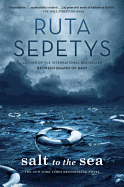
In Salt to the Sea, Ruth Sepetys (Between Shades of Gray; Out of the Easy) illuminates a lesser-known World War II maritime disaster: the Soviet torpedoing of the German ship Wilhelm Gustloff in the Baltic Sea on January 30, 1945, a tragedy that killed 9,343 evacuees--including 5,000 children--more than the Titanic and Lusitania combined. Sepetys's father's cousin Erika had passage on the Gustloff, but never boarded it.
Readers are introduced to the strong, distinct voices of four young adults in short, powerful blasts: Joana, a Lithuanian nurse; the pregnant, Polish Emilia; the Prussian restoration artist Florian; and Alfred, a twisted and zealous Hitler-loving sailor who imagines, but doesn't send, chilling, self-aggrandizing letters to his beloved Hannelore. Joana, Emilia and Florian meet randomly in East Prussia, all fleeing from the advancing Red Army, all hiding dangerous secrets that slowly reveal themselves. They move west across a wintery landscape with "a kindly shoemaker, an orphan boy, a blind girl, and a giantess," eventually making their way to Alfred's ship, the Wilhelm Gustloff, at the port of Gotenhafen.
"What had human beings become?" Florian wonders. "Did war make us evil or just activate an evil already lurking within us?" The ragtag crew braves freezing temperatures, hunger, Soviet planes and precarious ice crossings on their slow journey west, and win readers' hearts--and each other's--along the way. When the inevitable happens and the ship sinks, it's gruesome and gut-wrenching, but some do survive. In her intimate, extraordinary, artfully crafted novel, Sepetys shows both the wonder of humanity and the horror of dehumanizing people as "enemies" in wartime or any time. --Karin Snelson, children's & YA editor, Shelf Awareness

